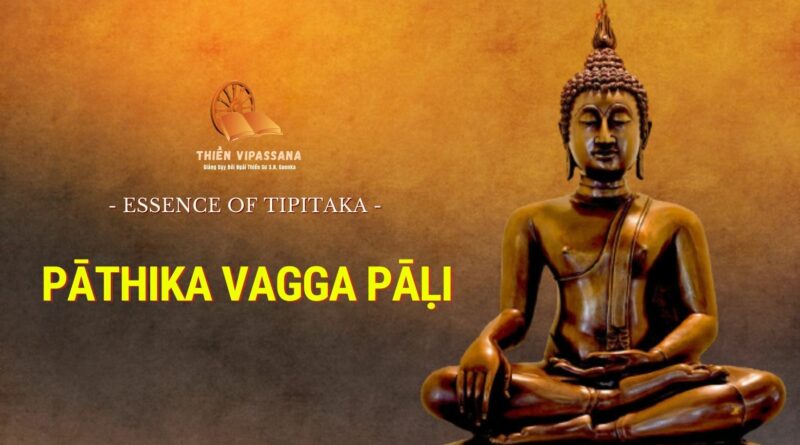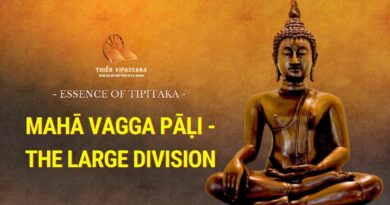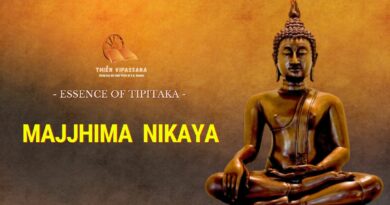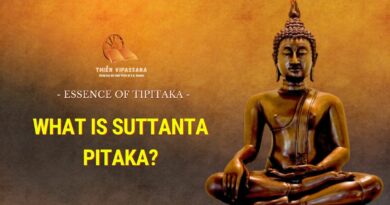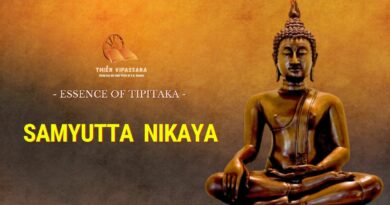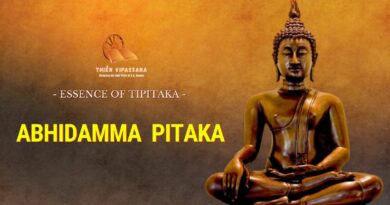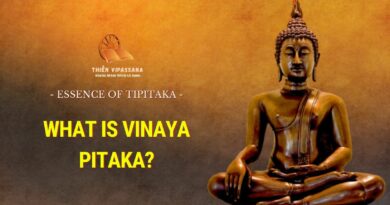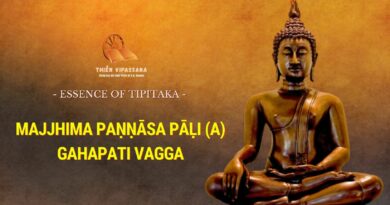3 Pāthika Vagga Pāḷi
This division is made up of eleven shorter discourses of a miscellaneous nature. They deal with the Buddha’s rejection of wrong and severe asceticism practised by followers of many sects. They deal also with the periodical evolution and dissolution of the universe, the accounts of universal monarchs and the thirty-two physiognomic characteristics of a great man. There is one discourse, Siṅgāla Sutta, addressed to a young brahmin showing the duties to be performed by members of the human society. The last two suttas, Saṅgīti and Dasuttara, are discourses given by the Venerable Sāriputta and they contain lists of doctrinal terms classified according to subject matter and numerical units. The style of their composition is different from the other nine suttas of the division.
Pāthika Sutta
At the time of the Buddha, there were many other teachers with their own disciples holding different views on what constituted the holy life, on the origin and development of the universe, and on the performance of wonders and miracles.
Sunakkhatta, a Licchavi prince, became a disciple of the Buddha and was admitted into the order. But he found the discipline and the teaching to be beyond him and his comprehension. He became at the same time attracted to the teachings and practices of other sects. He left the order after three years. Then becoming a follower of one of the sects he began to disparage the teachings of the Buddha, and made slanderous attacks on the Buddha and his disciples. In Pāthika Sutta are short discourses in which are accounts of the Buddha’s refutation and explanation with reference to many of Sunakkhatta’s accusations.
Udumbarikā Sutta
This discourse was given to Nigrodha, the wandering ascetic, and his followers in the park of the Queen Udumbarikā near Rājagaha in order to destroy their wrong doctrine and establish wholesome doctrine. So obsessed were the wandering ascetics with their own wrong beliefs that they gave no response to the Buddha’s invitation to follow his teaching which would assure them fruitful results within seven days.
Cakkavatti Sutta
In the town of Mātulā, in the country of Magadha, bhikkhus were enjoined by the Buddha to be their own support, their own refuge, relying only on the Dhamma and not on any other refuge. Then the Buddha told them the story of Daḷhanemi, the universal monarch who possessed the Celestial Wheel as one of his seven treasures. He and his successor ruled over the four continents, wielding the power and authority of the universal monarch. Their life-span was long, and as long as they remained righteous and fulfilled the noble duties of universal monarch, making the Dhamma their only support, providing shelter and security, offering wealth and necessities to the needy, their dominions remained at peace, were prosperous and progressing.
But when the monarch failed to fulfil the noble duties of a righteous king, when the Dhamma was no longer held as a refuge, the morality of the people declined. Their life-span dwindled down to ten years only. Then the ten meritorious deeds productive of wholesome effects completely disappeared and the ten evil deeds giving unwholesome results flourished exceedingly. People failed to show reverential regard for the leaders and elders, to fulfil their duties towards parents, samaṇas and brāhmaṇas. There also developed intense mutual aversion, ill-will, thoughts of killing one another, followed by fighting, devastation and carnage.
A few who survived the holocaust agreed to give up their evil ways, to live in a spirit of harmony, doing good deeds, showing reverential regard for the leaders and elders, fulfilling their duties towards parents, samaṇas and brāhmaṇas. In consequence of improved morality, their life-span expanded again until it reached eighty thousand years when a universal monarch appeared once more to rule righteously. Bhikkhus were thus enjoined to keep within the confines of the Dhamma, making it their support, their refuge. The Dhamma would show the way for their physical and mental development until they attained arahatship.
Aggañña Sutta
This discourse was given as Sāvatthi to two novices under training, Vāseṭṭha and Bhāradvāja, pointing out the wrong beliefs of brahmins as regards caste. The brahmins claimed that among the four classes of people recognised at that time brahmins were the noblest; next came the khattiya class (the nobility and royalty) followed by vessa (the trading class) and sudda (the lowest class).
The Buddha refuted these claims of the brahmins by explaining how the world was subjected to processes of evolution and dissolution and describing how human beings first appeared on earth and how the four social classes emerged. He explained further that the nobility of a person was decided not by his birth and lineage but by his morality and knowledge of the Noble Truths.
“Whoever holds wrong views and commits misdeeds is not noble whatever his birth. Whoever restrains himself in deed, word and thought and develops the bodhipakkhiya dhammas until he attains complete eradication of defilements in this very life is the chief, the noblest amongst men and devas irrespective of birth.”
Sampasādanīya Sutta
The Venerable Sāriputta’s deep confidence in the Buddha was once proclaimed aloud in an eloquent eulogy of the Buddha spoken in the Buddha’s presence. For making this bold utterance on the virtues of the Buddha, the Buddha asked him whether he had personal knowledge of the minds of all the Buddhas, those of the past, of the future and of the present, their morality, their concentration, their wisdom, and the manner of their emancipation.
The Venerable Sāriputta said he did not claim to have such knowledge but justified himself by stating in detail the course of the Dhamma taken by all the Buddhas, their accomplishment in sīla, abandonment of five hindrances, establishment in the four methods of steadfast mindfulness and cultivation of the seven factors of enlightenment-as being the only course that could lead to unsurpassed supreme enlightenment.
Pāsādika Sutta
The Venerable Ānanda accompanied by Bhikkhu Cunda went to see the Buddha to give him the news about the death of Nigaṇṭha Nāṭaputta, the leader of a well-known sect, and the schism that had arisen amongst his disciples.
The Buddha told them that it was natural and to be expected to happen in a teaching which was not well taught, not well imparted, not conducive to emancipation, and not taught by one who was supremely enlightened.
In contrast, the Buddha explained that when the teaching was well taught, well imparted by one who was supremely enlightened, there were no wrong views, no speculations about past or future or about atta. In the teaching of the Buddha, bhikkhus were taught the four methods of steadfast mindfulness by which wrong views and speculations were laid aside.
Lakkhaṇa Sutta
This discourse on thirty-two bodily marks of a great man was given by the Buddha at Sāvatthi in Anāthapiṇḍika’s Monastery. For a person endowed with the thirty-two bodily marks of a great man, only two possible courses are open to him and no other.
“If he lives the household life, he will become a universal monarch ruling in righteousness over the four continents. If he goes forth from the home life into homelessness, he will become an enlightened Buddha.”
The Buddha explained the thirty-two bodily marks in detail, together with accounts of meritorious deeds previously performed by virtue of which each of these thirty-two bodily marks were acquired.
Siṅgāla Sutta
This discourse was given by the Buddha at Rājagaha for the edification of a young man named Siṅgāla. The youth Siṅgāla used to worship the six cardinal points, namely, the east, the south, the west, the north, the nadir and the zenith in obedience to the last advice given by his dying father. The Buddha explained to the young man that according to his teaching the six directions were: the east standing for parents; the south standing for teachers; the west standing for the wife and children; the north standing for friends and associates; the nadir standing for servants, employees; the zenith standing for samaṇas, brāhmaṇas.
The Buddha explained further that the six social groups mentioned in the discourse were to be regarded as sacred and worthy of respect and worship. One worshipped them by performing one’s duties towards them. Then these duties were explained to the youth Siṅgāla.
Āṭānāṭiya Sutta
Four celestial kings came to see the Buddha and told him that there were non-believers among many invisible beings who might bring harm to the followers of the Buddha. The celestial kings therefore wanted to teach the bhikkhus the protecting incantation known as the Āṭānāṭiya Paritta. The Buddha gave his consent by remaining silent.
Then the four celestial kings recited the Āṭānāṭiya Paritta, which the Buddha advised the bhikkhus, bhikkhunis and lay disciples to learn, to memorize so that they might dwell at ease, well guarded and protected.
Saṅgīti Sutta
The Buddha was touring through the country of the Mallas when he came to Pāvā. The death of Nigaṇṭha Nāṭaputta had taken place only recently and his followers were left in dissension and strife, wrangling over doctrines.
The Venerable Sāriputta who delivered this discourse attributed this schism among Nāṭaputta’s followers to the fact the Nāṭaputta’s teaching had not been well taught nor well imparted, and was not conducive to release from the round of existences, being taught by one who was not supremely enlightened.
But the Buddha’s teaching was well taught, well imparted, conducive to release from the round of existences, being taught by the Buddha who was supremely enlightened. He advised the bhikkhus to recite the Dhamma as taught by the Buddha, in concord and without dissension so that the teaching should last long. Then he proceeded to enumerate the Dhamma classified under separate heads as group of the ones, group of the twos, etc., up to groups of the tens to facilitate easy memorizing and reciting.
Dasuttara Sutta
This discourse was also delivered by the Venerable Sāriputta, while the Buddha was staying at Campā, in order that the bhikkhus should get liberated from fetters and attain nibbāna, bringing about the end of suffering.
He taught the Dhamma classified under separate heads as group of the ones, group of the twos, etc., up to the groups of the tens.

